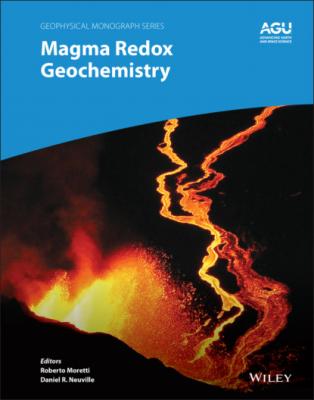Magma Redox Geochemistry. Группа авторов
Читать онлайн.| Название | Magma Redox Geochemistry |
|---|---|
| Автор произведения | Группа авторов |
| Жанр | Физика |
| Серия | |
| Издательство | Физика |
| Год выпуска | 0 |
| isbn | 9781119473244 |
The search for one general formulation for all melt compositions of interest in petrology and geochemistry led to empirical expressions, in which adjustable parameters are introduced without the formal rigor requested by Equation 1.56 (e.g. Kress and Carmichael, 1991). These formulations furnish quite accurate fO2 values from measured FeII/FeIII ratios within the compositional domain in which they have been calibrated. Besides, they often violate reaction stoichiometry and do not ensure internal consistency: if used to calculate activities they fail the application of the Gibbs‐Duhem principle relating all component activities within the same phase (e.g., Lewis and Randall, 1961). Such expressions then treat fO2 as a Maxwell’s demon, doing what we need it to do to fit the calibration data and with the consequence that outside the calibration domain, all the unpredictable non‐idealities are discharged on the fO2 terms, resulting in biased calculations of fluid speciation, or other phase equilibria constraints.
As extensively treated in Moretti (2020), unpredictable non‐idealities reflect counterintuitive behaviors that cannot be accounted for by activity coefficients used in the equilibrium constant of Reaction 1.55. It is well known that depending on melt composition alkali addition (i.e. decreasing pO2–) can either oxidize or reduce iron in the melt. This occurs because of the change of speciation due to the amphoteric behavior of FeIII, which depending on composition and then pO2– can behave as either network former or modifier (see the conceptualization provided by Ottonello et al., 2001; Moretti, 2005, 2020; Le Losq et al., 2020; see also Reaction 1.41). Models that define the melt (oxo)acidity (Reaction 1.27) hence pO2– (e.g; polymeric models based on the Toop and Samis mixing of bridging, non‐bridging and free oxygens; see Moretti, 2020, and references therein) allows solving speciation and set activity‐composition relations of ionic and molecular species, just as for aqueous solutions and molten salts.
The problem of unsolved compositional behaviors due to speciation, that are not accounted for by typical oxide‐based approaches to mixtures, is exacerbated when dealing with the mutual exchanges involving iron and another redox‐sensitive elements, such as sulfur. Sulfur‐bearing melt species play a special role since the oxidation of sulfide to sulfate involves eight electrons: for any increment of the FeIII/FeII redox ratio, there is an eight‐fold increment for sulfur species (S–II/SVI; e.g., Moretti and Ottonello, 2003; Nash et al., 2019; Cicconi et al., 2020b; Moretti and Stefansson, 2020). Sulfur in magmas partitions between different phases (gas, solids such as pyrrhotite and anhydrite, and liquid as well, such as immiscible Fe–O–S liquids; Baker and Moretti, 2011 and references therein). The large electron transfer makes S–II/SVI a highly sensitive indicator to fO2 changes in a narrow range (typically around QFM and NNO buffers in magmatic melts; Moretti, 2020 and references therein), whereas its effectiveness as a buffer of the redox potential is limited by the abundance of sulfur in magma, significantly lower than iron.
The modelling of joint Fe and S redox exchanges is still a major challenge which sees contrasting approaches (see Moretti, 2020). Formulations exist with various degrees of empiricism, but even those displaying better performances in exploring the fO2 – fS2 space of natural silicate melts (Moretti and Baker, 2008) should be carefully tested in reproducing phase diagrams involving multiple phases, including coexisting Fe–O–S melt, FeS(s), and Fe3O4(s). Introduction of sulfur equilibria in petrogenetic grids would be a major step forward for modelling in igneous petrology. Besides, it would provide the liaison with processes occurring in late‐ to post‐magmatic stages, prior to further cooling down to real hydrothermal conditions dominated by condensed water (see Figure 1.4). For late‐ to post‐magmatic stages, such as in the case of porphyry‐copper ore formation, logfO2‐logfS2 diagrams. Figure 7 reliably summarizes phase relations in the Fe–S–O system, in a way similar to Figure 1.2 and 1.4. It is worth noting that the diagram in Figure 1.7 can also be seen as resulting from reactivity of a sub‐solidus mixed iron molten oxide–sulfide, in which the two main ligands are O2– and S2– (half‐reactions 1.6, 1.11, and 1.12).
Figure 1.7 Two‐redox potential fO2‐fS2 diagram. The conformation of stability fields in the Fe–O–S space is essentially the same also for large fO2 and fS2 variations with temperature
(redrawn from Nadoll et al., 2011).
A natural assemblage of pyrite + magnetite + pyrrhotite corresponds then to the triple point marked by a star in Figure 1.7, which at a given T is invariant for fO2 and fS2 values given by the simultaneous occurrence of Reaction 1.10 and:
(1.57)
that allow identifying the stable phase as a function of temperature and fugacities (or activities) of reference gas species. It is worth noting that in absence of water (no H in the system represented in Figure 1.7) the boundary between FeS2 and FeS is a function of fS2 only (see Reaction 1.10) but not of fO2, as instead reported in Figure 1.4.
1.3. CONCLUDING REMARKS AND PERSPECTIVES
In this short compendium we show the redox features in aqueous‐hydrothermal and igneous Earth. This allows the summarizing of the main redox features of a system, to show what we know of its equilibrium properties, but also what we do not know, especially for melts and magmas. We make a parallel between redox in magmas and redox in aqueous‐hydrothermal solutions and show that what really
